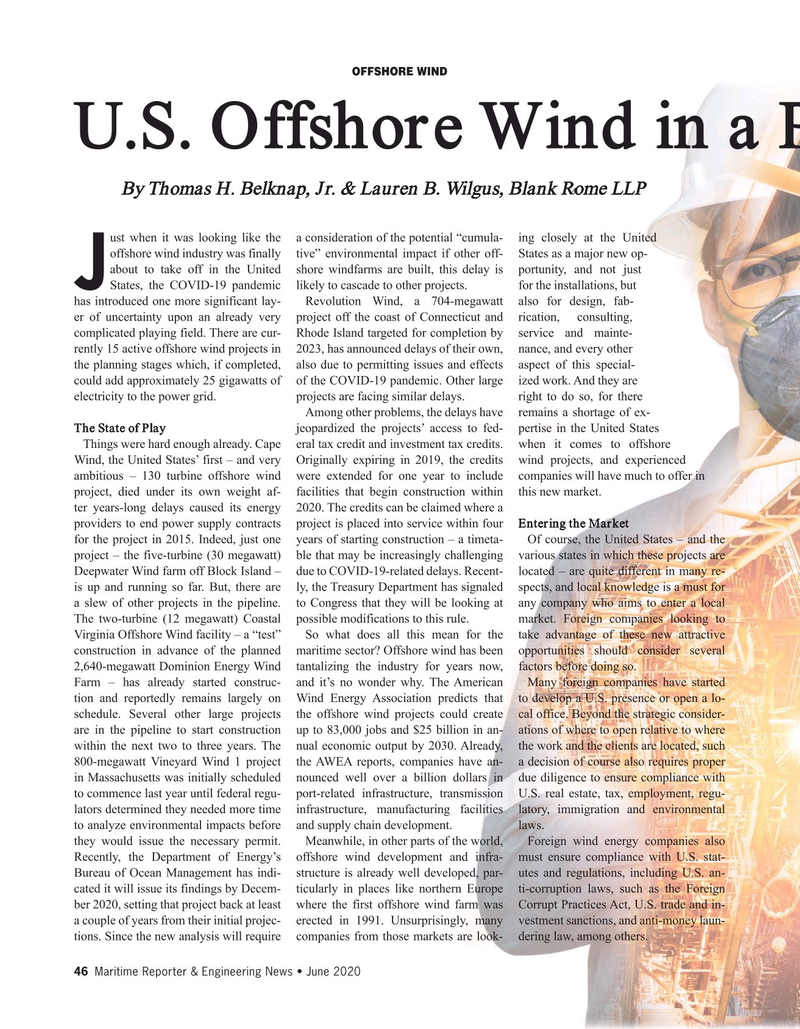
Page 46: of Maritime Reporter Magazine (June 2020)
2020 Yearbook
Read this page in Pdf, Flash or Html5 edition of June 2020 Maritime Reporter Magazine
OffshOre wind
U.S. Offshore Wind in a Post-COVID-19 World
By Thomas H. Belknap, Jr. & Lauren B. Wilgus, Blank Rome LLP ust when it was looking like the a consideration of the potential “cumula- ing closely at the United offshore wind industry was finally tive” environmental impact if other off- States as a major new op- about to take off in the United shore windfarms are built, this delay is portunity, and not just
JStates, the COVID-19 pandemic likely to cascade to other projects. for the installations, but has introduced one more significant lay- Revolution Wind, a 704-megawatt also for design, fab- er of uncertainty upon an already very project off the coast of Connecticut and rication, consulting, complicated playing field. There are cur- Rhode Island targeted for completion by service and mainte- rently 15 active offshore wind projects in 2023, has announced delays of their own, nance, and every other the planning stages which, if completed, also due to permitting issues and effects aspect of this special- could add approximately 25 gigawatts of of the COVID-19 pandemic. Other large ized work. And they are electricity to the power grid. projects are facing similar delays. right to do so, for there
Among other problems, the delays have remains a shortage of ex-
The State of Play jeopardized the projects’ access to fed- pertise in the United States
Things were hard enough already. Cape eral tax credit and investment tax credits. when it comes to offshore
Wind, the United States’ first – and very Originally expiring in 2019, the credits wind projects, and experienced ambitious – 130 turbine offshore wind were extended for one year to include companies will have much to offer in project, died under its own weight af- facilities that begin construction within this new market.
ter years-long delays caused its energy 2020. The credits can be claimed where a providers to end power supply contracts project is placed into service within four Entering the Market for the project in 2015. Indeed, just one years of starting construction – a timeta- Of course, the United States – and the project – the five-turbine (30 megawatt) ble that may be increasingly challenging various states in which these projects are
Deepwater Wind farm off Block Island – due to COVID-19-related delays. Recent- located – are quite different in many re- is up and running so far. But, there are ly, the Treasury Department has signaled spects, and local knowledge is a must for a slew of other projects in the pipeline. to Congress that they will be looking at any company who aims to enter a local
The two-turbine (12 megawatt) Coastal possible modifications to this rule. market. Foreign companies looking to
Virginia Offshore Wind facility – a “test” So what does all this mean for the take advantage of these new attractive construction in advance of the planned maritime sector? Offshore wind has been opportunities should consider several 2,640-megawatt Dominion Energy Wind tantalizing the industry for years now, factors before doing so.
Farm – has already started construc- and it’s no wonder why. The American Many foreign companies have started tion and reportedly remains largely on Wind Energy Association predicts that to develop a U.S. presence or open a lo- schedule. Several other large projects the offshore wind projects could create cal office. Beyond the strategic consider- are in the pipeline to start construction up to 83,000 jobs and $25 billion in an- ations of where to open relative to where within the next two to three years. The nual economic output by 2030. Already, the work and the clients are located, such 800-megawatt Vineyard Wind 1 project the AWEA reports, companies have an- a decision of course also requires proper in Massachusetts was initially scheduled nounced well over a billion dollars in due diligence to ensure compliance with to commence last year until federal regu- port-related infrastructure, transmission U.S. real estate, tax, employment, regu- lators determined they needed more time infrastructure, manufacturing facilities latory, immigration and environmental to analyze environmental impacts before and supply chain development. laws. they would issue the necessary permit. Meanwhile, in other parts of the world, Foreign wind energy companies also
Recently, the Department of Energy’s offshore wind development and infra- must ensure compliance with U.S. stat-
Bureau of Ocean Management has indi- structure is already well developed, par- utes and regulations, including U.S. an- cated it will issue its findings by Decem- ticularly in places like northern Europe ti-corruption laws, such as the Foreign ber 2020, setting that project back at least where the first offshore wind farm was Corrupt Practices Act, U.S. trade and in- a couple of years from their initial projec- erected in 1991. Unsurprisingly, many vestment sanctions, and anti-money laun- tions. Since the new analysis will require companies from those markets are look- dering law, among others. 46 Maritime Reporter & Engineering News • June 2020

 45
45

 47
47
